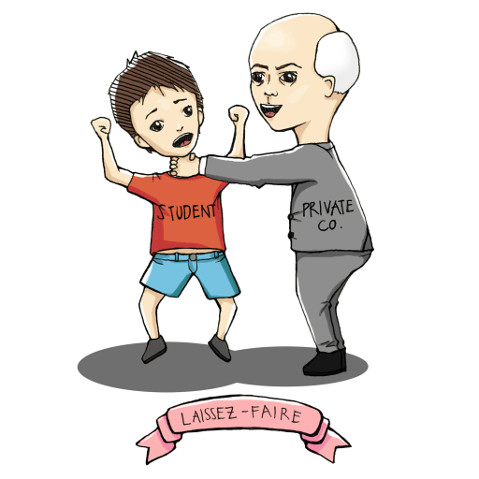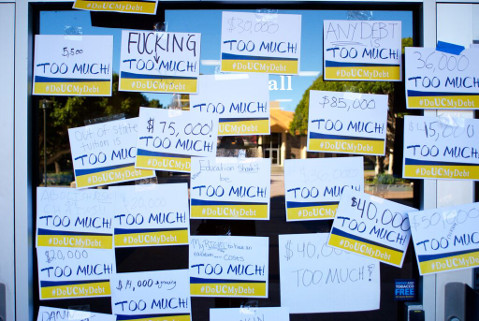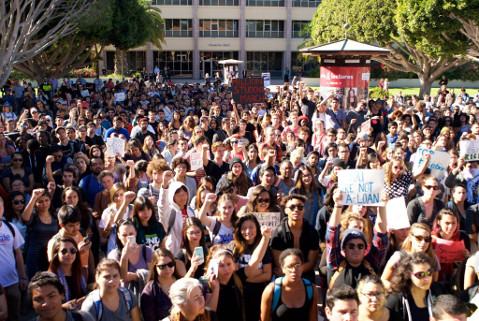Join the March, Join the Movement
State Should Invest in Higher Education, Not Prisons

I first heard of the UC Regents when I wrote my first check to them to pay for my education at UCSB. I hadn’t thought much of who these archetypal bureaucrats were, but I soon discovered that the Board of Regents consists of the following: 17 Regents (appointed by the governor for 12 years), seven Ex-Officio members, and only one student Regent who serves for one year. If the lack of student representation isn’t bothersome enough, all the current 17 appointed regents come from business backgrounds. In other words, there are 17 Regents who align with neoliberal ideas of the privatization of the public school system and only one Regent who represents the student voice.
In 1960, California developed the “Master Plan for Higher Education” which, in the words of UC’s Office of the President, “reaffirmed California’s prior commitment to the principle of tuition-free education to residents of the State.” This Master Plan served as a promise made by the UC Regents, UC President, and Governor Pat Brown to guarantee universal access to free higher public education. This is in direct contrast to the 2004 “Compact for Higher Education” contrived by Governor Schwarzenegger, the Regents, and UC President Robert Dynes. This Compact went in the complete opposite direction. It served as an explicit promise by the Governor that the UC will no longer look to the state for its main source of funding. Instead, the Compact has placed the burden of tuition on the shoulders of the student.
Effectively, the Compact has placed an economic barrier that systematically keeps students of lower economic status out of the UC system. The “American Dream” narrative is hard to maintain when the cost to attend and live at a university for one student costs more than $36,000 a year. To put that number in perspective, $18 an hour at a full-time job would bring in that amount annually. Even with the average financial aid package of $16,300, the average cost of attendance is around $19,000. That number becomes even more unaffordable for families with multiple students.
While the state is claiming the 2008 economic depression caused the loss of state funding, it is pouring these dollars into the industrial prison complex. The state spends on average annually $47,102 per prisoner, but only $8,482 per student; California has built 23 new prisons since 1980, but only one new university (UC Merced). These new prisons are disproportionately composed of people of color. Three out of every four prisoners is a man of color, even though they don’t commit more crimes proportionally and make up only 27 percent of the population. Instead of making a small investment by providing intervention programs to keep students in school, the state is paying a lot of money housing prisoners. The money being poured into the prison system is completely wasted; however, investing in keeping students in education creates a stronger California workforce.
More than 445 UC administrators make over $500,000 a year. An additional 255 UC administrators make over $400,000 a year. While administrators are siphoning money from the pockets of students, AFSCME 3299, the labor union representing UC workers, is fighting for a $15 an hour minimum wage for all workers on campus. Despite UC proudly publishing its wage increase to $15 per hour for UC-hired workers, it is also pushing strongly to outsource to contractors. Contracted workers aren’t extended the wages, health benefits, and union rights of UC workers, rights that should be guaranteed along with these wages.

On November 12, students across nine UCs and on over 100 universities and colleges across the country are joining the #MillionStudentMarch. In solidarity, students, faculty, and staff will march and make our three demands heard:
1.) Free public higher education
2.) Cancellation of student debt
3.) $15 per hour minimum wage
This march comes two days before the second Democratic Party Presidential Debate. The UCs expect to be large enough in number to create a large media narrative about the #MillionStudentMarch. Together, we can change the narrative behind higher public education. Come debate time, I am looking to see the candidates be asked hard questions about public higher education.
Solidarity is the key to a movement. Join the march. Join the movement.
Kyle Butts is a student organizer, writer, and ally at UC: Santa Barbara. He works in the Office of Associated Students’ External Vice President for Statewide Affairs.




